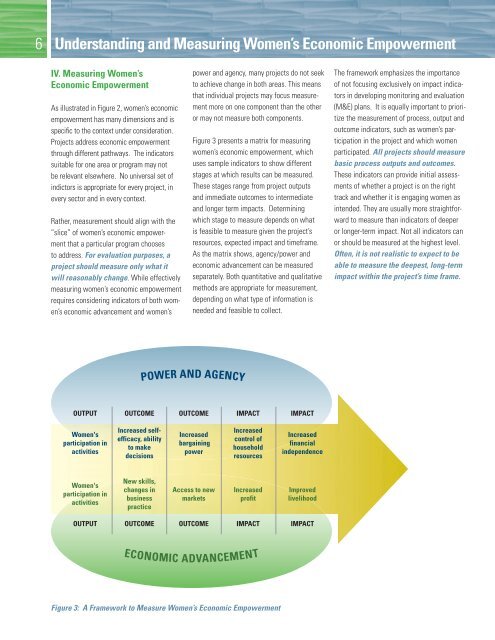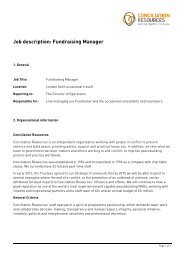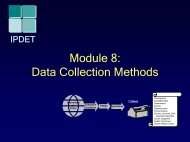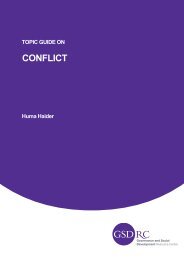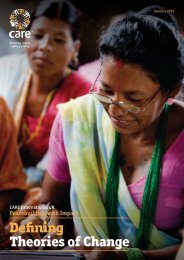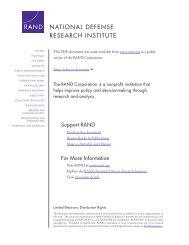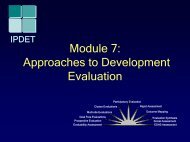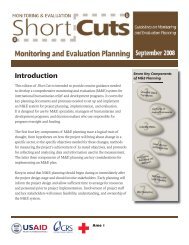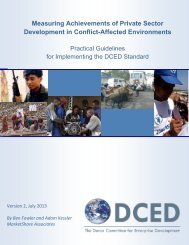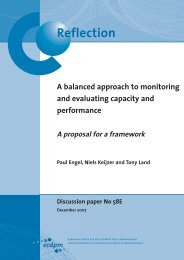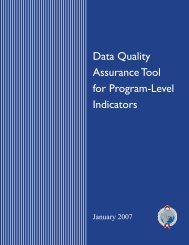Understanding and measuring womens economic ... - ICRW
Understanding and measuring womens economic ... - ICRW
Understanding and measuring womens economic ... - ICRW
Create successful ePaper yourself
Turn your PDF publications into a flip-book with our unique Google optimized e-Paper software.
6<strong>Underst<strong>and</strong>ing</strong> <strong>and</strong> Measuring Women’s Economic EmpowermentIV. Measuring Women’sEconomic EmpowermentAs illustrated in Figure 2, women’s <strong>economic</strong>empowerment has many dimensions <strong>and</strong> isspecific to the context under consideration.Projects address <strong>economic</strong> empowermentthrough different pathways. The indicatorssuitable for one area or program may notbe relevant elsewhere. No universal set ofindictors is appropriate for every project, inevery sector <strong>and</strong> in every context.110613 <strong>ICRW</strong> Folder graphics B G Y:11-0 10/7/11 9:06 AM Page 3Rather, measurement should align with the“slice” of women’s <strong>economic</strong> empowermentthat a particular program choosesto address. For evaluation purposes, aproject should measure only what itwill reasonably change. While effectively<strong>measuring</strong> women’s <strong>economic</strong> empowermentrequires considering indicators of both women’s<strong>economic</strong> advancement <strong>and</strong> women’spower <strong>and</strong> agency, many projects do not seekto achieve change in both areas. This meansthat individual projects may focus measurementmore on one component than the otheror may not measure both components.Figure 3 presents a matrix for <strong>measuring</strong>women’s <strong>economic</strong> empowerment, whichuses sample indicators to show differentstages at which results can be measured.These stages range from project outputs<strong>and</strong> immediate outcomes to intermediate<strong>and</strong> longer term impacts. Determiningwhich stage to measure depends on whatis feasible to measure given the project’sresources, expected impact <strong>and</strong> timeframe.As the matrix shows, agency/power <strong>and</strong><strong>economic</strong> advancement can be measuredseparately. Both quantitative <strong>and</strong> qualitativemethods are appropriate for measurement,depending on what type of information isneeded <strong>and</strong> feasible to collect.The framework emphasizes the importanceof not focusing exclusively on impact indicatorsin developing monitoring <strong>and</strong> evaluation(M&E) plans. It is equally important to prioritizethe measurement of process, output <strong>and</strong>outcome indicators, such as women’s participationin the project <strong>and</strong> which womenparticipated. All projects should measurebasic process outputs <strong>and</strong> outcomes.These indicators can provide initial assessmentsof whether a project is on the righttrack <strong>and</strong> whether it is engaging women asintended. They are usually more straightforwardto measure than indicators of deeperor longer-term impact. Not all indicators canor should be measured at the highest level.Often, it is not realistic to expect to beable to measure the deepest, long-termimpact within the project’s time frame.POWER AND AGENCYOUTPUTOUTCOMEOUTCOMEIMPACTIMPACTWomen'sparticipation inactivitiesIncreased selfefficacy,abilityto makedecisionsIncreasedbargainingpowerIncreasedcontrol ofhouseholdresourcesIncreasedfinancialindependenceWomen'sparticipation inactivitiesNew skills,changes inbusinesspracticeAccess to newmarketsIncreasedprofitImprovedlivelihoodOUTPUTOUTCOMEOUTCOMEIMPACTIMPACTECONOMIC ADVANCEMENTFigure 3: A Framework to Measure Women’s Economic Empowerment


